“Make Do and Mend” (2016-17) is artwork created by Anna Dumitriu as part of The FEAT (Future Emerging Art and Technology) residency programme. The piece references the 75th anniversary of the first use of penicillin in a human patient in 1941 and takes the form of an altered antique wartime women’s suit marked with the British Board of Trade’s utility logo CC41, which stands for ‘Controlled Commodity 1941’ meaning that the use of materials has been deemed meet the government’s austerity regulations.
The holes and stains in the suit have been patched and embroidered with silk patterned with E. coli bacteria grown using a dye-containing growth medium, forming pink colonies or spots.
The genomes of these E. coli bacteria have been edited using a technique called CRISPR to remove an ampicillin antibiotic resistance gene and repaired using a technique called homologous recombination to scarlessly patch the break with a fragment of DNA (converted into ASCII code and then to base 4) encoding the WWII slogan “Make Do and Mend”, which encouraged housewives to repair their clothes during the wartime rationing period.
Ampicillin is part of the penicillin group of beta-lactam antibiotics so in a way it is conceptually and poetically true to say that, with this artistic genomic edit, Anna Dumitriu and her collaborator Dr Sarah Goldberg have used today’s latest technology to ‘mend’ the organism back to its pre-1941, pre-antibiotic era state. Scientifically it is far more complex in that they have used a lab strain of TOP10 E. coli that is very well characterized and has had many other modifications so it will never really be the same as it was in 1941.
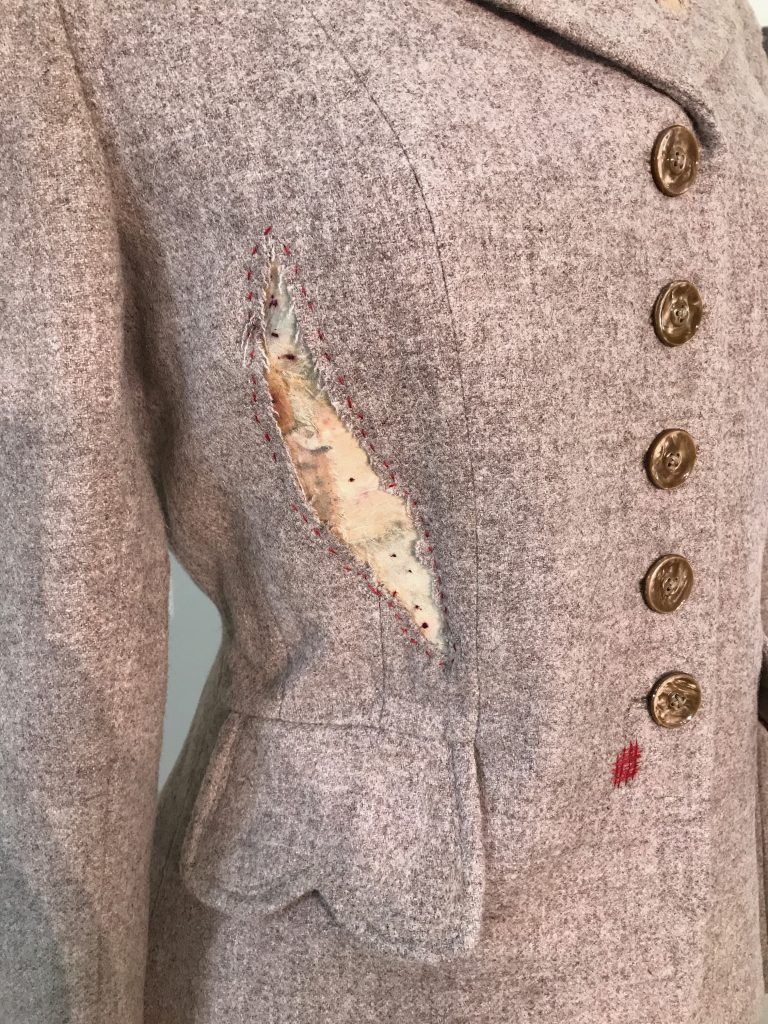
We now face a serious global problem of antibiotic resistance as disease-causing bacteria evolve mechanisms to resist our attempts to destroy them, and the wonder drugs, such as penicillin, no longer work. This is in some part because we have misused these drugs since we kick-started the arms race of the antibiotic age in 1941.
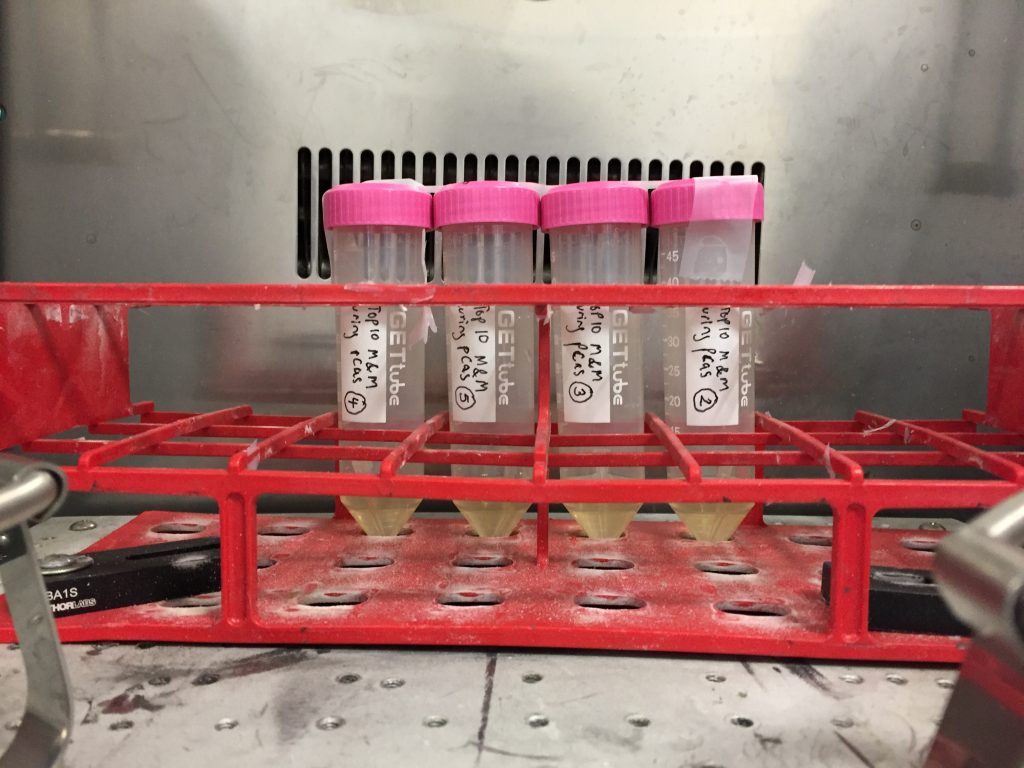
Our antibiotic stocks have not been protected as the ‘controlled commodities’ they should have been. As a counterpoint today’s governments now seek to control the use of CRISPR but this is difficult because of its accessibility and potential to revolutionize biotechnology.

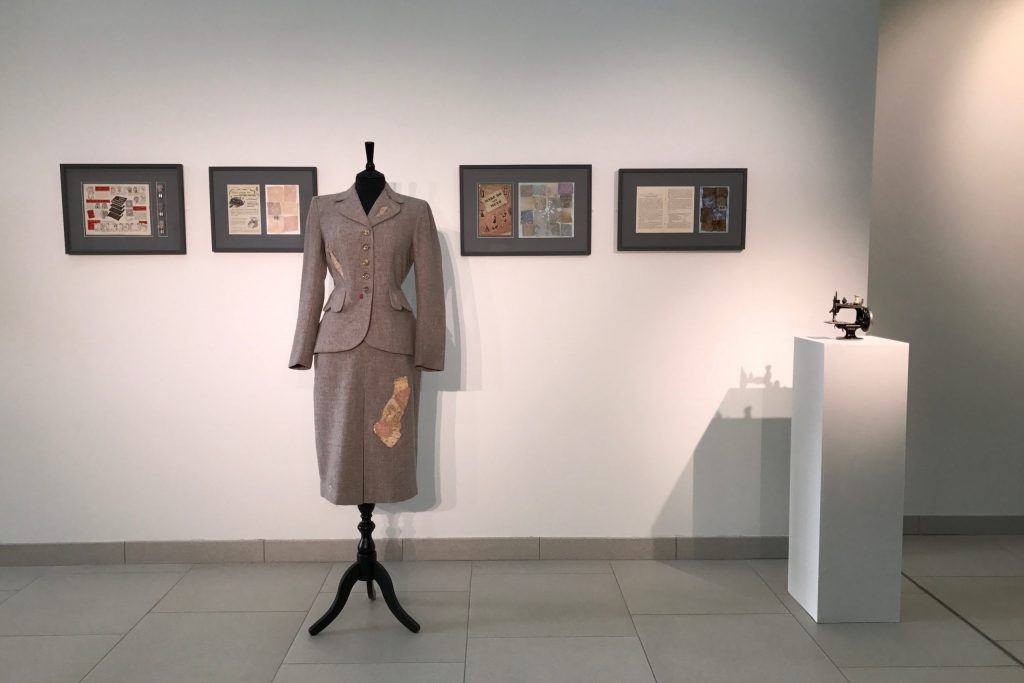

Controlled Commodity

“Controlled Commodity: is a second instantiation of the work also comprising a CC41 dress patched with the “Make Do and Mend” E. coli strain, exhibited alongside the plasmids used in the its CRISPR modification and the entire antibiotic arsenal currently in use in hospitals today.
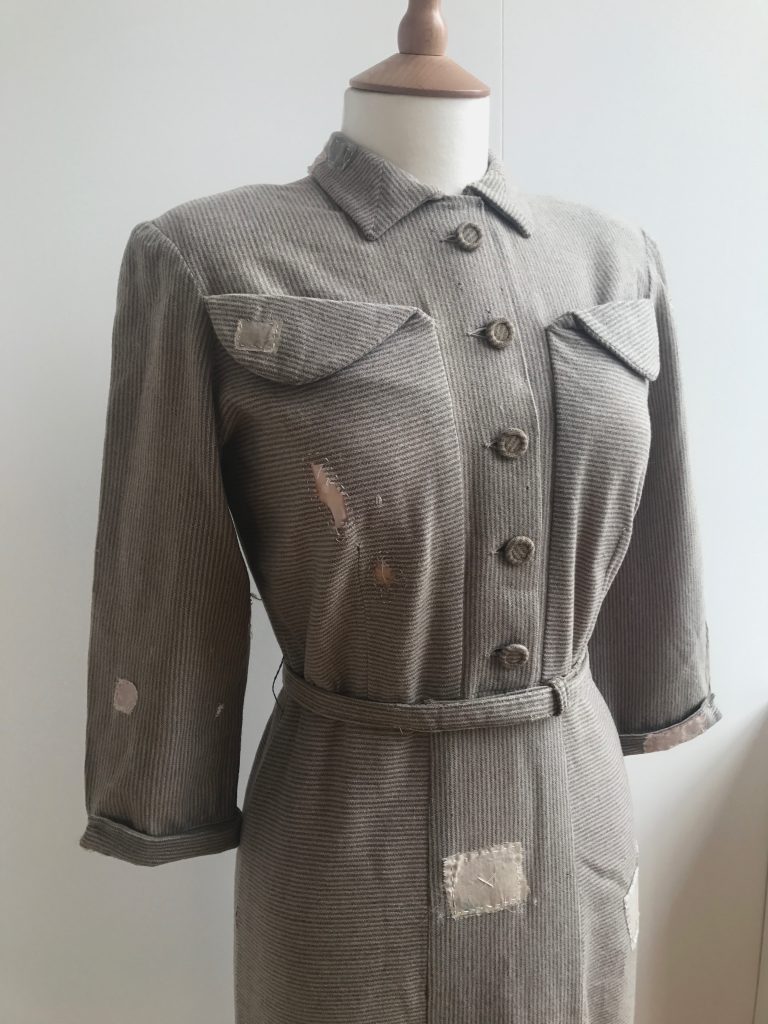
Dumitriu has worked extensively with bacteria as an artistic medium as well developing projects with whole genome sequencing and synthetic biology. By embedding herself in the research being undertaken by MRG Grammar she has been able to build on her existing knowledge and learn about how gene expression is regulated. She shadowed researchers, worked hands on in the lab and is now continuing to develop a body of artworks that explore and communicate MRG-Grammar’s research an accessible and multi-layered way.
“I work by developing in-depth collaborations through embedded residencies shadowing researchers and working hands on in the lab to understand the research, methods and processes. I use the raw materials of research to create my artworks, performances and participatory workshops. I am looking forward to building on my recent projects focusing on whole-genome sequencing and synthetic biology through my FEAT Residency.“
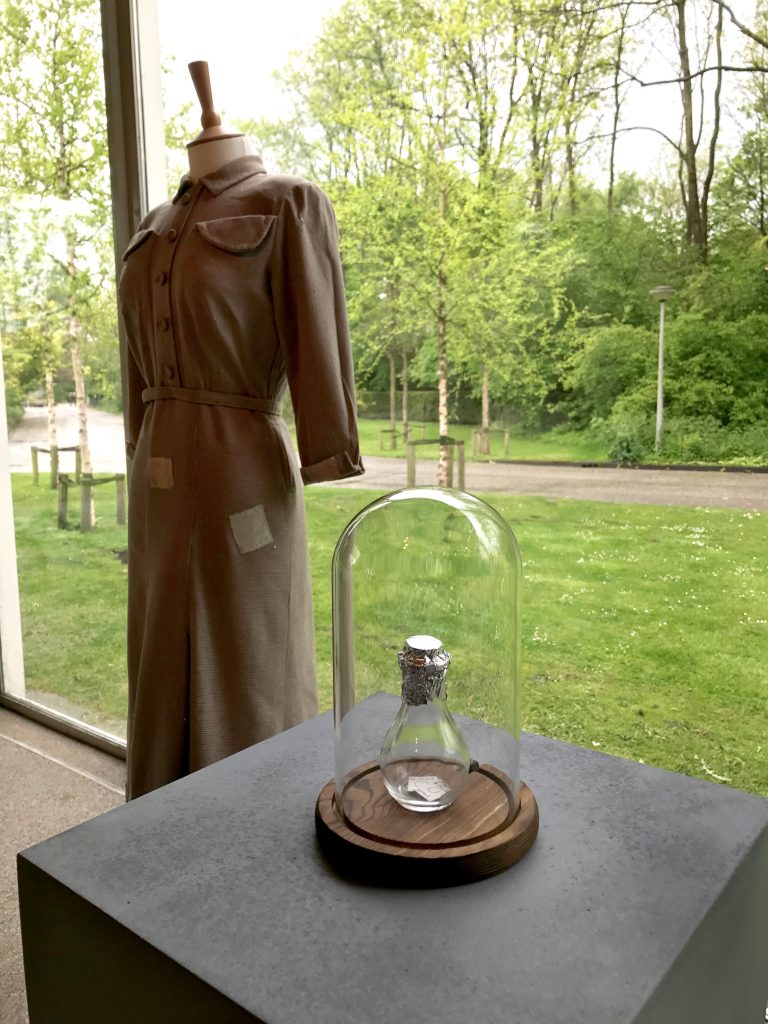
Awards
“Make Do and Mend” was nominated for the EU STARTS Prize at Ars Electronica in 2017.
Exhibitions
“Make Do and Mend” was exhibited at LifeSpace Dundee in Scotland from Friday 14th April – Saturday 17th June 2017 as part the Future Emerging Art and Technology exhibition.
“Controlled Commodity” was shown at Zone2Source Gallery in Amsterdam at part of the “Trust Me, I’m an artist” exhibition 13th May – 25th June 2017.
“Controlled Commodity” was exhibited at Art Electronica Festival from 7th – 11th September 2017 at POSTCITY in Linz, Austria.
“Controlled Commodity” was exhibited at the BOZAR Electronic Arts Festival in Brussels from 14th – 30th September 2017 and Anna Dumitriu discussed her project there on a FEAT panel.
“Make Do and Mend” was exhibited at The Museum of the History of Science in Oxford, UK as part of Anna Dumitriu’s solo exhibition BioArt and Bacteria from 28th September 2017 until 18th March 2018.
“Make Do and Mend” was part of “The World Unseen: Intersections of Art and Science“, David J. Sencer CDC Museum: In Association with the Smithsonian Institution, Atlanta, USA 20th May – 30th August 2019.
“Make Do and Mend” was part of “Wunderkammer BioArt“, Kunsthaus Wiesbaden, Wiesbaden, Germany, 7th April – 26th June 2022.
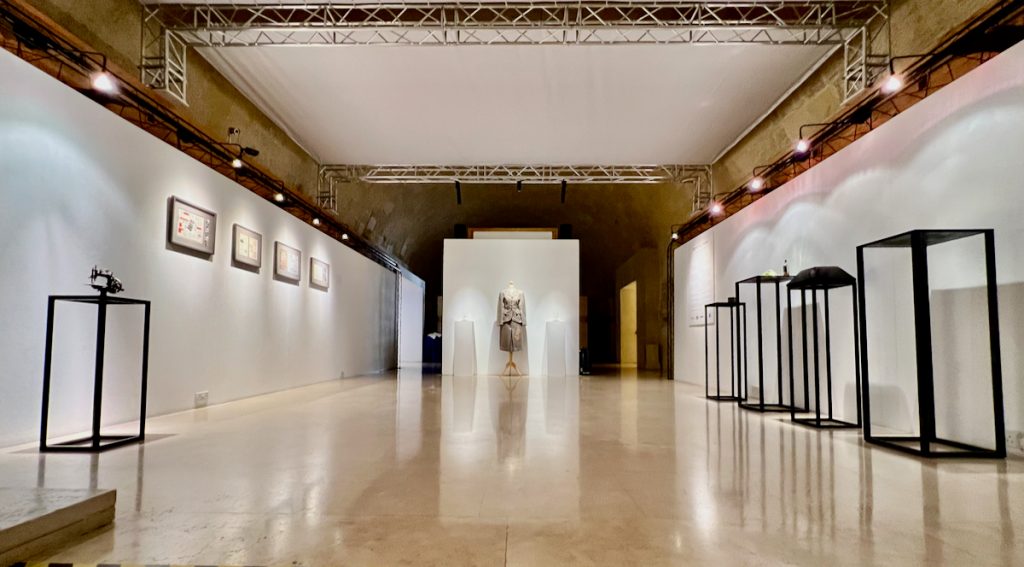
“Make Do and Mend” was exhibited at Spazju Kreattiv in Valletta, Malta, as part of “BioArt Alchemy” a solo exhibition of works by Anna Dumitriu, from 16th September 2022 to 30th October 2022.

“Make Do and Mend” was part of BioArt Revolution/ Revoluția BioArt, an innovative solo exhibition by Anna Dumitriu which brought together contemporary artistic approaches and modern scientific experiments to address issues of global relevance such as infection, climate change, and diversity took place as part of Timișoara 2023 European Capital of Culture, from 30th September to 1st October 2023. The exhibition, which was created in collaboration with the Romanian Science Festival, took place in the stunning setting of Bastionul Maria Theresia, Galeria 2, Str. Hector, nr. 1, Timișoara, Romania.
“BioArt Knowledge” at the Yarrow Gallery, Oundle, UK from 9th November to 6th December 2023.

Fragile Microbiomes (solo exhibition) at the Thackray Museum of Medicine, Leeds, UK, from 10th February to 23rd June 2024.
Media, Publications and Articles
Cover image for the Centers For Disease Control (CDC) Journal of Emerging Infectious Diseases Vol. 25, Issue 1, and article Repurpose and Reuse: Artistic Perspectives on Antimicrobial Resistance by Bryron Breedlove (USA), January 2019
The CRISPR Journal (Volume 1, Issue 5) featured Make Do and Mend and the BioArt and Bacteria exhibition in CRISPR Gene Editing Meets the Art World: A New Exhibition Including Perhaps the First Application of CRISPR Gene Editing Technology in BioArt is Coming to America by Professor Miguel Ángel Medina of University of Málaga, (USA), October 2018.
Anna Dumitriu and Sarah Goldberg wrote an article for Leonardo Journal Make Do and Mend: Exploring Gene Regulation and CRISPR through a FEAT (Future Emerging Art and Technology) Residency with the MRG-Grammar Project”, published on just accepted page, hosted by MIT Press doi: 10.1162/LEON_a_01466, (USA), June 2017
Clara Rodríguez Fernández wrote an article Trust me, I’m an Artist Explores the Ethics of Biotech in Amsterdam about the exhibition and featured “Controlled Commodity” on for Labiotech.eu, in May 2017
Interview about “Trust Me, I’m an Artist” and “Controlled Commodity” (produced as part of the FEAT project) on Dutch National Radio 1 (in Dutch) May 2017
Review of the “Trust Me, I’m an Artist” exhibition at Zone2Source in Amsterdam by Nora Vaage, featuring “Controlled Commodity” on Furtherfield.org, May 2017
Regine Debatty reviewed the exhibition for We Make Money Not Art, June 2017
Review of the Trust Me, I’m an Artist exhibition at LifeSpace Dundee by Julia Buntaine, featuring “Make Do & Mend” on SciArt Magazine Blog, June 2017
Interview with Anna Dumitriu by Richard Bright in Interalia Magazine Make Do and Mend and CRISPR gene editing, July 2017
Review of the “Trust Me, I’m an Artist” exhibition at Zone2Source in Amsterdam by Julia Buntaine, featuring “Controlled Commodity” on SciArt Magazine Blog, July 2017
Interview with Dr Sarah Goldberg The Bacteria Talk about the MRG-Grammar Project by Giuseppe Saija for Youris/FEAT, October 201
Interview with Anna Dumitriu about her work Bacterial BioArt by Giuseppe Saija for Youris/FEAT, October 2017
Interview with Anna Dumitriu about her FEAT residency Sharing stories from the world of bacteria by Giuseppe Saija for Youris/FEAT, October 2017
Article BioArt: L’Art Issu Du Labo, published in French by Technion France (France/Israel), October 2017
Talks
Anna Dumitriu led a guided “Experts Tour: Controlled Commodities: Ethics and Materiality” on 9th September 2017, 11:00 AM-12:30pm, where attendees explored the artworks and projects on show at POSTCITY at Ars Electronica that raise complex ethical issues about developments in science and technology, either in their use of materials or subject matter. Artist Anna Dumitriu also introduced her own project Controlled Commodity.
She also spoke on 9th September 2017 on the FEAT panel and present “Controlled Commodities” on 10th September 2017 on the STARTS Symposium: ART, SCIENCE & TECHNOLOGY COLLABORATIONS IN EUROPE.
Anna Dumitriu discussed “Make Do and Mend” at BOZAR Electronic Arts Festival in Brussels and on a panel on the FEAT Project in September 2017.
About the Future Emerging Art and Technology (FEAT) Residency Programme and the Collaboration with MRG-Grammar
The Future Emerging Art and Technology project partners some of Europe’s most innovative scientists with artists working at the cutting edge of technology to create a productive atmosphere where participating artists will learn new skills and work with novel materials, while scientists gain new perspectives and learn new ways to make their work to the public. Anna Dumitriu is the FEAT artist partner and, as well as working with the co-ordination of the programme, has undertaken a residency with the European Future Emerging Technology Horizon 2020 project MRG-Grammar (Massive Reverse Genomics to Decipher Gene Regulatory Grammar).
MRG-Grammar aims to devise a new strategy for deciphering the regulatory rules of gene regulation. Using Synthetic Biology, DNA synthesis and high-throughput analysis the project will generate new types of biological datasets that systematically explore all possible regulatory landscapes. The project will employ a strategy on diverse model organisms, from single cell to whole organism: bacteria, yeast, mouse ex-vivo cells, human cell-lines and finally, whole D. melanogaster and mouse embryos. The project expects its models to also serve as a reference in designing and implementing accurate and more controllable synthetic biology devices, with applications in fuel production, healthcare and other industrial fields.
Dumitriu was in residence with The Teichmann Lab at The Wellcome Trust Sanger Institute in Cambridge, UK in October 2016 to explore their work in trying to understand how enhancer genes influence the 1% of genes (in mammalian cells) that actually make proteins. In the future this area of research is likely to be hugely important in understanding health and disease.
Dumitriu worked with Sarah Teichmann, Head of Cellular Genetics at the WT Sanger Institute, and researchers including Xi Chen, Michal Kosicki, and Tomas Pires de Carvalho Gomes, looking at ChIP-sequencing, the use of CRISPR/Cas9 gene editing tools, high throughput sequencing technologies for single cell genomics, and bioinformatics approaches to handing the large amounts of data produced.
In November 2016 Dumitriu travelled to The Segal Lab at the Weizmann Institute in Tel Aviv, Israel where she worked mainly with Adina Weinburger, Maya Lotan-Pompan and Hadas Elisar. As part of the project she learned to whole genome sequence her gut microbiome and developed an understanding of using synthetic DNA libraries to search for potential targets for novel antibiotics. She also gave a talk at the Weizmann Institute and also another for the public at DIYbio Israel, at the Google Campus Tel Aviv.
In December 2016 She travelled to Haifa and worked The Amit Synthetic Biology Laboratory for the Decipherment of Genomic Codes at Technion in Haifa, Israel to learn how to edit bacterial genomes in their regulatory regions. She also gave a talk at Technion on her work. She returned to Haifa in 2017 to complete the work.
A report paper on the FEAT event at Ars Electronica Festival 2016 in Linz, Austria, where Anna Dumitriu was interviewed by internationally renowned curator Annick Bureaud, can be accessed here.
Thanks also to Dr Heather Macklyne, Dr Nicola Fawcett, Dr John Paul, Kevin Cole and Dr James Price for their additional support in creating this project.
FEAT is funded by the EU backed programme FET (Future and Emerging Technologies) Open. It has received funding from the European Union’s Horizon 2020 research and innovation programme under grant agreement No 686527 (H2020-‐FETOPEN-‐2015-‐CSA)
